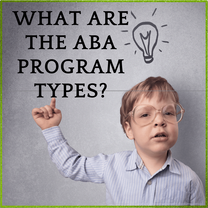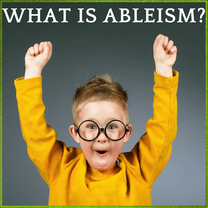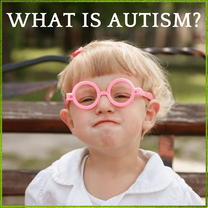More About Social and Communication Delays
|
In order to be diagnosed with autism, a child must demonstrate a significant delay in the development of social skills. A person can be diagnosed at any age, but the characteristics must have been present before age three.
When comparing a child with autism to their undiagnosed peers, one might notice differences in their interactions with peers and with their environment. For example, a child with autism might seem more interested in picking at dirt on the ground, walking the perimeter of a playground, or spinning in circles than in participating on the playground equipment with their peers. Most children with autism have limited eye contact and social referencing skills, so they have trouble picking up on indirect social cues. Some children have severe social delays, in which they simply do not appear to be interested in others (though this might not actually be so). They might actively avoid engaging with others (particularly other children or adults that may place demands on them) or seem not to be aware of their surroundings. (Again, just because it seems so doesn’t necessarily mean this is so.) Another person with ASD may attempt to interact with peers but exhibit unusual social behaviors and therefore be repeatedly rejected by peers. This history of rejection can be painful and result in a hesitancy to try again in the future. Yet another person may show an interest in peers but observe quietly “on the sidelines,” seemingly unsure of how to act or what to say. Communication delays in some form must also be present in individuals with autism. Sometimes this is very subtle and sometimes it is very clear. Language Development: Some children develop words easily and rapidly, others very slowly; others develop words, lose them for a period of time, and then slowly regain them once again at a slow pace; some children do not speak until much later in development than expected; and still others gain very few words at all. When spoken language is delayed, augmentative communication can be taught. Sign language is a good alternative, but when a child has delays in fine motor development, sign language is not the best option. Instead or in addition to sign language, picture communication can be a highly effective way to teach a person to self-advocate and comment on their environment. Echolalia Many children with autism develop immediate and or delayed echolalia as part of their speech patterns. Echolalia is not at all a bad thing, but it is important to understand. Immediate Echolalia: When a person demonstrates immediate echolalia, they repeats sounds, words, phrases or sentences that have just been said. Here’s an example of the different forms immediate echolalia can take. Let’s say a caregiver asks their child, “Do you want hot chocolate?” Here are some examples of what a child might say in return if they are demonstrating immediate echolalia.
The function immediate echolalia occurs can vary, but it is a good indication that either:
In other words, immediate echolalia is a sign that the individual is trying to communicate, but is unable to do so in a manner others can understand clearly. It is a good thing that our learners are trying to communicate with us! All we need to do is help them understand the question. Once we can teach them to answer correctly according to their preferences, they won’t miss out on the yummy hot chocolate or, alternatively, they can make sure they don’t have to drink the yucky hot chocolate (depending on the preferences and motivations of the person, of course)! Delayed Echolalia: Delayed echolalia is slightly different from immediate echolalia, because it can happen anywhere, any time, and under any circumstances. It involves the repetition of a sound, word, phrase, or sentence heard in the past, usually word-for-word, and often using the same intonations. Delayed echolalia is harder to identify than immediate echolalia, but parents and teachers are pretty good at identifying when it is happening because they have an extended history with the individual. They can detect patterns, and often will even know where an echolalic response originated. Think of it like a vocal “copy and paste.” There are different general reasons for this behavior, so let’s break the examples down. The first reason is during initial language development. The child may only know one way of saying something, so they stick to it. This is common with many children regardless of diagnosis. They remember a word or phrase that was taught to them. They don’t have a better-fit expression for it or they don’t know how to vary it, so they stick with the same “script.” When we see this happen, we are not discouraged. We celebrate! Then, we teach vocal flexibility slowly over time. The second reason is for more advanced functional communication. This is just an extension of the first reason, but it is more complex and we see it often with people who are very good at rote memorization. The person remembers a time in the past where they saw, experienced, or felt something similar. Because of their extraordinary memorization skills, they remember something that was said at the time when that something similar happened, and they “paste” the phrase or sentence into the current situation, regardless of whether it makes sense to other people. It makes sense to them. The sentence that is pasted could be anything anyone said, a sound effect that was heard, a song that was playing, a sentence from a movie, etc. It is an impressive skill when you think about it. When people demonstrate this type of echolalia, it is not a matter of discouraging this. Instead, we can work to understand what they mean and then assist them by giving them different ways to express what they mean whenever possible. This will help them to be understood more easily by others. The third reason delayed echolalia may occur has very little to do with social communication. Rather, a song, word, sound effect, phrase, or sentence is repeated (and sometimes repetitively repeated) for the simple joy of it. It may bring the person comfort in times of stress, it may be a reminder to the person, it may be pleasing to the ear. Regardless, the person isn’t speaking to another person, but to themselves. There is nothing wrong with this (everyone talks to themselves sometimes, right?). However, a person who does this can be encouraged to engage in this behavior quietly or when alone to prevent people from misunderstanding the behavior. A final note about language and echolalia: It’s complicated. Really complicated. Words can be combined in countless ways to convey the same meaning, and yet altering a word in the wrong way presents the danger of saying something we don’t mean. If your learner has echolalia, it is usually a coping strategy. They are doing their best to find the closest match to the situation. It is important not to discourage echolalia, but rather to encourage the development of vocal flexibility. It is possible that over time, the learner will develop the ability to do vocal gymnastics! This would be great, but remember not everyone can be a gymnast. Teach and encourage but let them grow the way they need to |
|
Copyright © 2015 | 7500 Arroyo Circle, Suite 180, Gilroy, CA 95020 | 408-418-7121 |






